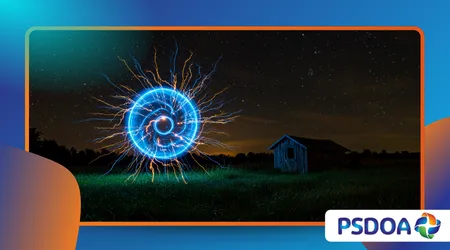The Mystery of Ball Lightning: What We Know So Far

The natural world is full of unexplained events, but few are as eerie and captivating as the mystery of ball lightning. Imagine a glowing orb hovering silently in the air, sometimes flickering or darting unpredictably, and then vanishing as quickly as it appeared.
Anúncios
Witnessed for centuries across the globe, this phenomenon has inspired awe, confusion, and no small amount of skepticism.
Despite its long history, ball lightning remains one of the least understood atmospheric phenomena.
It doesn’t appear during every thunderstorm, and it defies most conventional explanations. For scientists and observers alike, it’s a puzzle that still resists easy classification.
A Phenomenon Rooted in Folklore and Eyewitness Accounts
The mystery of ball lightning has been recorded since the early 1600s. Sailors reported glowing spheres hovering over the sea.
Anúncios
Farmers described balls of fire floating into their homes during storms. Some accounts mentioned orbs that passed through glass or left behind the smell of sulfur.
Because of its rarity and the unpredictable nature of its appearance, ball lightning was often dismissed as myth.
Only in the 20th century did mainstream science begin to take it seriously, especially as pilots and trained weather observers began to report similar sightings.
A recent review published in the journal Nature compiled over 10,000 eyewitness reports globally—most of them consistent in shape, color, and behavior.
That’s a staggering number for something that science still can’t fully explain.
What Might It Be? Theories That Try to Explain
There’s no shortage of ideas. Some researchers believe ball lightning is a plasma-based event, created when electrical energy becomes briefly trapped in a self-contained structure.
Others suggest it may be a result of chemical reactions between atmospheric gases triggered by lightning strikes.
A popular model involves silicon particles. According to this theory, lightning strikes the ground and vaporizes silica-rich soil. The silicon forms clusters in the air that ignite and form glowing spheres.
Though compelling, this explanation still doesn’t account for all reports—especially those that describe ball lightning indoors or during calm weather.
What complicates the mystery of ball lightning is its variability. Some orbs last for seconds, others for minutes. Some explode, others fade away quietly.
That inconsistency makes it difficult to replicate or study in laboratory conditions.
An Original Example: A Close Encounter in a Library
In 1976, a university staff member in Argentina claimed to witness a glowing orb float into a library during a thunderstorm. It moved silently between shelves before exiting through a window, leaving scorched marks on nearby books. The building’s electrical systems malfunctioned shortly afterward.
The witness described the orb as no larger than a grapefruit, glowing white-blue and emitting a faint buzz. While never officially confirmed, similar reports from the same region lend credibility to the account. Cases like this one illustrate just how unpredictable and intimate the experience of ball lightning can be.
Another Example: A Military Sighting Above the Sea
In the late 1980s, a naval officer on a submarine off the coast of Norway reported seeing two luminous spheres hover above the water during calm weather.
Radar systems recorded no anomalies, but the orbs remained visible to the naked eye for nearly a minute before dissipating.
Unlike lightning, which occurs in split seconds, these orbs exhibited stable movement and even slight changes in altitude.
Though declassified, the incident never led to conclusive findings. But it contributed to the body of military documentation on unexplained aerial phenomena.
The Role of Technology in Unraveling the Mystery
With advances in imaging, sensors, and atmospheric modeling, researchers are closer than ever to demystifying this phenomenon.
High-speed cameras and satellite data have helped confirm that ball lightning is not an illusion or purely anecdotal.
In 2012, Chinese scientists studying a thunderstorm with spectrometers accidentally recorded a ball lightning event.
The data matched many existing theories and offered rare, measurable insight. It was the first time a spectral analysis had been conducted on a confirmed sighting.
This type of evidence is helping transform the mystery of ball lightning from pseudoscience into a legitimate scientific inquiry.
A Statistic That Highlights Its Rarity
According to the Global Lightning Detection Network, over 1.4 billion lightning strikes occur annually. Yet only a tiny fraction—fewer than 0.005%—are associated with credible reports of ball lightning.
That means for every 200,000 lightning strikes, there might be just one ball lightning event. It’s no wonder the phenomenon remains elusive.
Why Ball Lightning Still Matters
Some may ask: why spend resources chasing a floating orb? But the mystery of ball lightning touches on fundamental questions about how energy behaves in the atmosphere.
If we can understand ball lightning, we may unlock insights into plasma physics, electromagnetic fields, or even new forms of energy storage. In a way, it’s like decoding a hidden language spoken by storms.
And let’s be honest—doesn’t the world need a little mystery?
FAQ
What is ball lightning?
Ball lightning is a rare, glowing, spherical electrical phenomenon usually seen during thunderstorms. Its cause remains largely unknown.
Can ball lightning be dangerous?
Yes. While many instances are harmless, some have caused fires, injuries, or equipment failures.
Has ball lightning ever been captured on camera?
Yes. A few rare recordings exist, including a 2012 event in China that provided useful scientific data.
Is ball lightning the same as St. Elmo’s Fire?
No. St. Elmo’s Fire is a corona discharge seen on pointed objects. Ball lightning is a free-floating, glowing sphere.
Are there official studies on ball lightning?
Yes. Several academic institutions and meteorological agencies have conducted studies, though the phenomenon is still under investigation.
The mystery of ball lightning continues to glow faintly on the edge of science—visible, recorded, but still not fully understood. And perhaps, that’s what makes it so electrifying.
